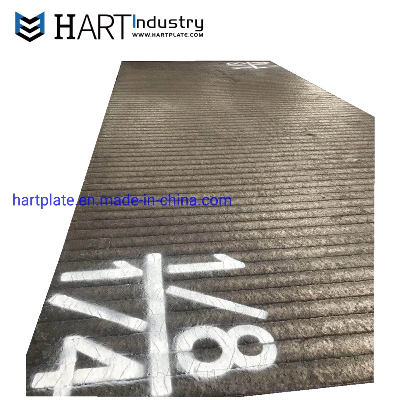Chromium Carbide Overlay Wear/Abrasion Resistant Hard Facing
Bimetal Steel Dua Plate for Chute/Hopper/Feeder/Bucket/Cone
LinerHART Plate is manufactured by depositing chromium-rich,
abrasion-resistant materials on mild steel base plate using
a traditional arc welding process. This product is usually
referred to as chromium carbide overlay (CCO) plate on the market.
The hardfacing overlay is suitable for severe abrasive wear and
impact applications. Qingdao HART Industrial Technology Co., Ltd
was established in 2003, it had a long history of providing
innovative wear solution and world class wear products. The
ultimate hardfaced product for your application depends on the
material--whether rock, sand, gravel or other substance--striking
or sliding along the surface of your wear part. It also depends on
the angle and speed of impact as well as the operating
temperature. NOPRODUCT
ITEMDESCRIPTIONAPPLICATION1HART-P-200Chromium Carbide Overlay
PlateSliding Wear2HART-P-100Chromium Carbide Overlay PlateSevere
Sliding Wear3HART-P-80Complex Carbide Overlay PlateExtreme Sliding
Wear[Technical Specification Of HART-P-100 ] 1. Base
Material: ASTM A36(Q235B), ASTM A529A(Q345B), other weldable
steel is optional; Base thickness: 3 to 30 mm 2.
Hardfacing Layer: Chromium carbon alloy on Fe
basis(austenite) Bulk hardness: >630HV Mean hardness: >55HRC
Layer thickness: 3 to 30 mm 3. Welding Processes:
Advanced open arc welding and submerged arc welding 4. Alloy
Description: Austenitic chrome carbide iron(Chromium white
iron) 5. Carbide Hardness: >1500HV 6. Volume Fraction of
Carbide: >30% 7. Chemical Composition: Carbon: 3-6%
Chromium: 18-34% *Various alloys to be used depend on different
operating condition and applications.
ThickC%Cr%Mn%Si%HRC 3 on
33~418~200.5~10.5~156~58 3 on
43~418~200.5~10.5~156~58 3 on
53~418~220.5~10.5~158~60 3 on
N3.5~4.520~250.5~10.5~158~62N>54 on
N3.5~4.520~250.5~10.5~158~625 on N4~623~250.5~10.5~158~626 on
N4~624~280.5~10.5~158~627 on N4.5~624~280.5~10.5~158~628 on
N4.5~624~280.5~1.50.5~158~629 on N5~626~300.5~1.50.5~160~6410 on
N5~626~300.5~1.50.5~160~6411 on N5~626~300.5~1.50.5~160~6412 on
N5~626~340.5~1.50.5~160~64N on N5~626~340.5~20.5~160~64N>128.
Microstructure: Composed of a high proportion of
extremely hard primary M7C3 chromium rich carbides dispersed in
a ductile eutectic austenite matrix. Maintains 30% to
50% of primary carbides to provide a good wear resistance and
homogenous bonding. 9. Typical Applications: HART-P-100
Plate is widely used in the mining, power generation(Coal), cement,
dredging, steel production, waste handling, glass production, and
pulp and paper industries. Some specific applications
include: INDUSTRYAPPLICATONSMiningChutes, hoppers, liners for
truck beds, dozer blades, shovel buckets, dragline buckets,
excavatorsCementSeparator guide vanes, discharge cones for clinker
storage bins, chutes for sintering ore conveying, outlet ducts for
clinker grinding mills, receiving hoppersDredgingDredging pipes and
pumps, suction pipelines, pump dischargesSteelDredging pipes and
pumps, suction pipelines, pump dischargesPowerCoal handling chutes,
coal feeder liners, crusher screen plates, classifier cones,
journal liners, silo bunkers10. Wear properties of HART-P-100 (ASTM
G65 and SGS test report) *ASTM G65 is a standard test
measuring sliding abrasion resistance using a dry sand/rubber
wheel apparatus. HARDBANDING ALLOYASTM G65 -- WEIGHT
LOSSHARDNESS (RC)10+10-80.162 g/6000 revs64.710+10-40.183 g/6000
revs63.710+10-20.149 g/6000 revs64.011. Service
SERVICEDESCRIPTIONCutting1. Can be cut by plasma, laser, water jet,
arc gouge, and abrasive saw cutting; 2. Cannot be cut by
oxy-fuel. Welding1. Use 480 MPa (70 ksi) or 560 MPa (80 ksi)
consumable to join base metal; 2. After welding, joint should
be capped by overlay for wear protection. Machining1. Not
machinable by conventional methods; 2. Can be finished by
grinding only; 3. Countersunk holes can be precisely produced
by EDM (Electrical Discharge Machining). Forming1. Commonly
formed with overlay to the inside; 2. For pipes with diameters
smaller than 0.6m (24"), hardfacing pipe recommended instead of
pipes fabricated from hardfacing plate. Drilling1. When
drilling, the distance between two holes should be at least 15mm
(5/8''); Otherwise, the partition may not be strong enough and can
crack; 2. The minimum diameter of holes should be equal to the
thickness of the plates. For thicker plates with a total
thickness over 20mm (3/4''), the minimum diameter should be 1.5
times the thickness of the plate. 12. Testing and quality
control We documented how the product properties are tested in
order to make sure the overlay plates fulfil the specified product
properties. Including documentation on 3D party's quality system if
calibration and testing is performed by 3D party. 13. Packing
and loading /* January 22, 2024 19:08:37 */!function(){function
s(e,r){var
a,o={};try{e&&e.split(",").forEach(function(e,t){e&&(a=e.m
Related products about Chromium Carbide Overlay Wear for Chute/Hopper/Feeder/Bucket/Cone Liner
-
 Waste Tyre Plastic Recycling Machinery Machine Tire Crusher Production Line Rubber Crumb Grinding Machine Equipment Tire Shredder
Waste Tyre Plastic Recycling Machinery Machine Tire Crusher Production Line Rubber Crumb Grinding Machine Equipment Tire Shredder
-
 Stretch Plastic Blowing Pet Bottle Making Blow Molding Machine Bottles Stretch Automatic Pet Bottle Blowing Machine
Stretch Plastic Blowing Pet Bottle Making Blow Molding Machine Bottles Stretch Automatic Pet Bottle Blowing Machine
-
 Waste Plastic Pet Bottle, Water Bottle Flake, PP/HDPE/LDPE PE Film Jumbo Woven Bags Plastic Crusher Machine, Plastic Crushing Washing Recycling Machine
Waste Plastic Pet Bottle, Water Bottle Flake, PP/HDPE/LDPE PE Film Jumbo Woven Bags Plastic Crusher Machine, Plastic Crushing Washing Recycling Machine
-
 Type 2 Wall-Mounted Electric Car Charging Station 7kw /11 Kwelectric Vehicle Charging Station Home Wallbox AC EV Charger Single Phase or 3three Phase
Type 2 Wall-Mounted Electric Car Charging Station 7kw /11 Kwelectric Vehicle Charging Station Home Wallbox AC EV Charger Single Phase or 3three Phase
-
 G-View G12W Wholesale Auto Car LED Headlight Bulb High Power H13 H11 9005 H7 H4 Car LED Headlights LED Car Lights
G-View G12W Wholesale Auto Car LED Headlight Bulb High Power H13 H11 9005 H7 H4 Car LED Headlights LED Car Lights
-
 New Design Porcelain Round Plates Dinner Set for Wedding and Banquet
New Design Porcelain Round Plates Dinner Set for Wedding and Banquet
-
 China 2023 New Design Super Soft 100% Polyester Microfiber Knitted Oversized Decoration Hoodie Blanket
China 2023 New Design Super Soft 100% Polyester Microfiber Knitted Oversized Decoration Hoodie Blanket
-
 Handmade Art Creative Materials Thickened White Paper Cup DIY Disposable Handmade Colored Paper Cup
Handmade Art Creative Materials Thickened White Paper Cup DIY Disposable Handmade Colored Paper Cup



